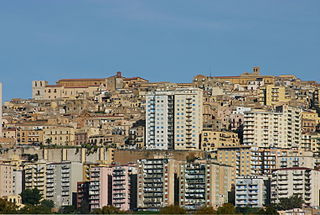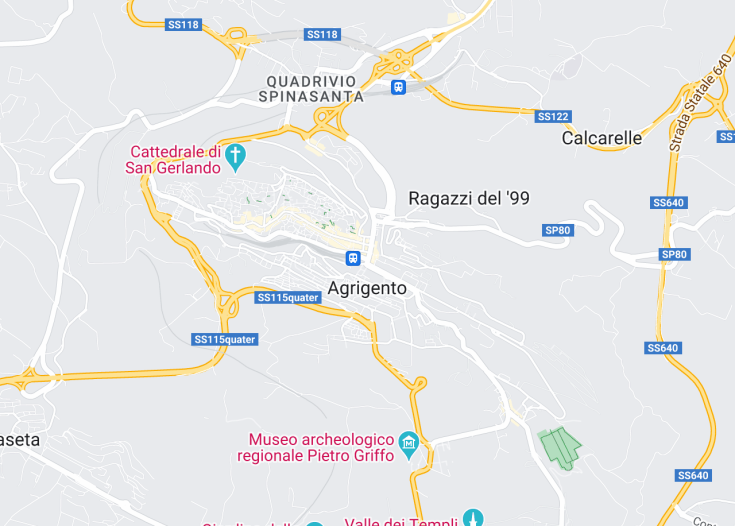Nestled on the southern coast of Sicily, Agrigento is a treasure trove of history and culture, renowned for its magnificent Valley of the Temples. This UNESCO World Heritage site boasts some of the best-preserved Ancient Greek structures, spectacularly perched overlooking the azure Mediterranean sea. Beyond its ancient ruins, Agrigento enchants with its medieval old town, vibrant local festivals, and gastronomy that features delectable Sicilian flavors. Its charm extends to the nearby beaches, offering visitors a serene escape alongside historical exploration.
Ensure to visit in spring to enjoy comfortable weather and the splendid Almond Blossom Festival, which transforms Agrigento with vibrant festivities and floral beauty.
Consider a guided tour of the Valley of the Temples to gain deeper insights into its historical significance and architectural marvels.
Top things to do & see in Agrigento
Select the following sights and activities to discover best tickets and tours available in Agrigento.
Agrigento: Heart of Ancient Sicily
| Country | Italy |
| Time in Agrigento | GMT+1 |
| Language spoken | Italian |
| Population | 59,797 (source: ISTAT, 2021) |
| Currency | Euro (€, EUR) |
| Airports |
|
Agrigento, located on the southern coast of Sicily, Italy, is a stunning city rich in history and culture. Originally founded as Akragas around 582 BCE by Greek settlers, the city was once one of the leading cities in the Mediterranean world. Its renown stems significantly from the Valley of the Temples, a UNESCO World Heritage site brimming with some of the best-preserved Ancient Greek temples and structures. This archaeological marvel offers a panoramic insight into the grandeur of ancient architectures, such as the Temple of Concordia, which is among the most illustrious and well-preserved Doric-style structures.
Aside from its historical importance, Agrigento is also known for its captivating natural landscapes, including the Scala dei Turchi, a stunning white limestone cliff shaped by wind and waves into wide, terraced steps. Its unique geological formation, along with the contrasting azure of the Mediterranean, makes it a spectacular sight and a popular attraction among tourists and photographers alike.
Also notable is the city’s modern Italian culture, with a vibrant annual Almond Blossom Festival, which showcases folklore groups and traditional dances, celebrating the advent of spring and the rich agricultural tapestry of the area. Surrounded by almond trees, Agrigento becomes a home to lively streets, scent of almond blossoms, and the sounds of Sicilian musical expressions during this period.
The cuisine in Agrigento reflects its rich culture. Dishes such as Pasta alla Norma and Arancini embody the traditional flavors that are a medley of Greek and Roman influences. Ingredients like almonds and olives, harvested from local farms, are staples in the local diet and are often celebrated in the regional dishes.
Internationally, Agrigento remains a symbol of Greek civilization’s reach and influence in the Mediterranean. The city not only promotes Sicily’s historic landscape but also serves as a living museum, offering insights into ancient lives and civilizations with every stone and artifact. Its ongoing efforts in preserving such a rich heritage is a testament to the city’s respect and passion for its roots and history.
Where is Agrigento?
Agrigento is situated on the southern coast of Sicily, Italy’s largest island, southwest of the island’s capital, Palermo.
Distances:
| Route | Distance by car | Time by car |
|---|---|---|
| Palermo to Agrigento | 84 miles (135 km) | 1h 50m |
| Catania to Agrigento | 106 miles (170 km) | 2h 10m |
| Trapani to Agrigento | 100 miles (161 km) | 2h 20m |
What is Agrigento famous for?
Agrigento is renowned for the Valley of the Temples, an outstanding archaeological site that hosts an exceptional group of ten Doric temples from the ancient Greek civilization.
History
Prehistoric to Classical Antiquity (Before 582 BC)
The area around modern-day Agrigento, known historically as Akragas, is rich with evidence of prehistoric human activity. Archaeological findings suggest that long before classical antiquity, this region was frequented by the indigenous Sicani people, influenced over millennia by successive waves of Sicels and later Phoenician traders.
Classical Period (582 BC – 210 BC)
The official founding of Agrigento is traced back to 582 BC by settlers from Gela, a nearby Greek colony. It swiftly rose to prominence, becoming one of the leading cities of Magna Graecia during the classical period. The city is renowned for its magnificent temples, such as the Valley of the Temples, which remains a testament to its past glory. In 406 BC, Agrigento faced a massive Carthaginian attack and was subsequently captured but managed to regain some of its power, which lasted until the Roman conquest in 210 BC.
Roman and Medieval Era (210 BC – 1400 AD)
Under Roman rule, Agrigento was known as Agrigentum, serving as an important hub within the empire, though it never regained its ancient prosperity. Following the fall of the Roman Empire, Agrigento experienced a period of decline before it flourished anew under Byzantine and later Arab domination, when it was known as Kerkent. The Arab influence is particularly noted for innovations in agriculture, including the introduction of crops such as sugarcane and cotton.
Modern Era (1400 AD – Present)
The transition into the modern age saw Agrigento under various powers, including the Normans, Swabians, and the Spanish before it became part of the unified Kingdom of Italy in 1860. In the 20th century, Agrigento expanded beyond its ancient centre, with modern developments and archaeological tourism becoming crucial aspects of its economy, preserving its rich historical tapestry while evolving into a vibrant contemporary city.
Visit Agrigento
What to see and do in Agrigento
Agrigento, a historical gem in Italy, is primarily renowned for the Valley of the Temples, a UNESCO World Heritage site that is one of the most outstanding examples of Greater Greece art and architecture. Additionally, visitors can explore:
- The Archaeological Museum, which holds key artifacts that narrate the region’s history.
- The medieval core of the city, with its narrow streets and the Cathedral of San Gerlando.
- The nearby beaches, offering a blend of relaxation and beautiful landscapes.
Moreover, the city’s vibrant streets are lined with shops and cafes where one can taste local Sicilian cuisine.
Festivals in Agrigento
Agrigento hosts several cultural and historical events throughout the year. Notably, the Almond Blossom Festival in February features folk groups, music, and traditional dances, celebrating the coming spring amidst the blossoming almond trees.
Best time to visit Agrigento
The best times to visit Agrigento are spring (April to June) and early autumn (September and October). These periods offer mild weather, which is ideal for exploring the archaeological sites and less crowded conditions, enhancing the visitor experience.
Is Agrigento worth visiting?
Agrigento is certainly worth visiting, not only for its archaeological marvels like the Valley of the Temples but also for its vibrant culture and spectacular natural scenery. The blend of historical richness with the charm of Sicilian life makes Agrigento a compelling destination for travelers seeking a deep dive into history, culture, and natural beauty.
What are the top attractions to visit in Agrigento?
Agrigento, renowned for its rich archaeological legacy, boasts several must-see attractions. The most famous is the Valley of the Temples, a stunning UNESCO World Heritage site that features well-preserved Ancient Greek temples. Another important site is the Archaeological Museum, which offers insights into the area’s history with an extensive collection of artifacts. For nature lovers, the Kolymbethra Garden, an ancient garden recently restored by the Italian Environmental Fund, provides a lush escape amidst historical ruins. Lastly, the historic center of Agrigento presents a charming array of medieval and Baroque architecture, enhancing a tour through its narrow streets.
What are the best outdoor activities in Agrigento?
Agrigento offers a variety of outdoor activities that cater to both history enthusiasts and nature lovers. Walking tours through the Valley of the Temples are a popular choice, providing an up-close view of its ancient structures. For beachgoers, the nearby Scala dei Turchi with its white marl cliffs and turquoise waters offers a unique beach experience. Hiking enthusiasts can explore the paths around Monte Cammarata for breathtaking views of the Sicilian landscape. Additionally, the Torre Salsa Nature Reserve presents an excellent spot for bird watching, hiking, and enjoying serene beach settings.
What are the best day trips from Agrigento?
One of the best day trips from Agrigento is to the stunning Scala dei Turchi, a remarkable white cliff on the coast that offers exquisite photographic opportunities and relaxing beaches. Another worthwhile excursion is to the town of Piazza Armerina to visit the Villa Romana del Casale, famed for its intricate Roman mosaics. For a taste of charming Sicilian towns, a trip to Caltagirone, known for its ceramics and splendid Staircase of Santa Maria del Monte, is highly recommended. Lastly, exploring the ancient Greek ruins at Selinunte, one of the most impressive archaeological sites in the Mediterranean, is a rewarding day trip.
What are some hidden gems in Agrigento?
Beyond its famous archaeological sites, Agrigento harbors several hidden gems worth exploring. The Garden of Kolymbethra is an enchanting haven often overlooked by tourists, providing a serene environment amid ancient ruins. The Quarters of the Rabato, near the historic center, is a quaint area with medieval streets that reflect the diverse history and cultures that have shaped the city. For a unique spiritual experience, the underground Catacombs of St. Biagio offer a glimpse into the early Christian era of Sicily. Lastly, the local wineries around Agrigento provide tastings of regional wines typically not found in tourist circuits.
Where are the best places to eat in Agrigento?
Agrigento boasts a variety of dining options that highlight the rich Sicilian cuisine. For a traditional meal, La Posata di Federico II offers dishes prepared with fresh, local ingredients and provides a charming ambiance. Those looking for seafood can head to Trattoria Caico, well-known for its fresh fish and sea view. For a unique dining experience, Osteria Expanificio offers a blend of contemporary and traditional cooking, situated in a beautifully restored building. Vegetarians will enjoy the imaginative dishes at Naif, a restaurant that combines modern culinary techniques with local produce.
Where can I enjoy local wine tasting in Agrigento?
Agrigento and its surroundings are part of the Sicilian wine route, offering numerous spots for tasting local wines. The Mandrarossa Vineyards offer guided tours and tastings, showcasing their renowned wines with an emphasis on indigenous grape varieties. For a historical winery experience, visit the Planeta Ulmo Estate, which combines wine tastings with tours of their ancient cellars and scenic vineyards. Another notable winery is the Cantina Settesoli, which not only provides a diverse selection of wines but also engages in sustainable viticulture practices.
What are the best souvenirs to bring back from Agrigento?
When shopping for souvenirs in Agrigento, consider items that capture the essence of Sicilian culture. Ceramics crafted in Caltagirone are beautifully designed and make for vibrant reminders of your visit. Another popular souvenir is olive oil, especially from local producers who use traditional methods for a pure taste. For something uniquely Sicilian, pick up a bottle of Limoncello or local wine, such as a bottle from the Nero d’Avola grape. To satisfy sweet tooths, bring back some almond sweets and pastries, like marzipan fruits and cannoli, which are stapes of Agrigento’s confectionery.
Are there any traditional festivals in Agrigento I should know about?
Agrigento hosts several festivals throughout the year that celebrate its rich tradition and culture. The Almond Blossom Festival, held annually in February, marks the beginning of spring with traditional dances, food stalls, and a competitive fireworks display. In summer, the Sagra del Mare in San Leone is a must-attend for seafood lovers, featuring endless dishes of freshly caught fish and musical performances. Another significant cultural event is the ancient religious festival of San Calogero, observed in July with a vibrant procession through the city, traditional music, and plenty of local foods.









